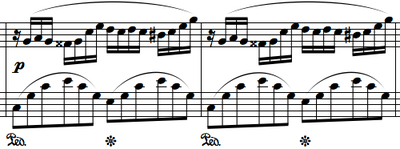Fantaisie-Impromptu

Frédéric Chopin's Fantaisie-Impromptu in C-sharp minor, Op. posth. 66, is a solo piano composition. It was composed in 1834 and published posthumously in 1855 although he had instructed that none of his unpublished manuscripts should be published.[1] Despite negative comments, the Fantaisie-Impromptu is one of Chopin's most frequently performed and popular compositions.[2]
History
The Fantaisie-Impromptu was written in 1834, as were the Four Mazurkas (Op. 17), and the Grande valse brillante in E-flat major (Op. 18), but, unlike these other works, Chopin never published the Fantaisie-Impromptu. Instead, Julian Fontana published it posthumously, along with other waltzes Opp. 69 and 70.[3] It is unknown why Chopin did not publish the Fantaisie-Impromptu. James Huneker calls parts of it "mawkish" and "without nobility".[4] Ernst Oster writes that a technical exploration would show why Chopin did not publish the work, and that exploration shows that the Fantaisie-Impromptu and Beethoven's Moonlight Sonata ("Quasi una fantasia") are related.[5]
The mystery may have been solved in 1960 when pianist Arthur Rubinstein acquired the "Album of the Baroness d'Este" which had been sold at auction in Paris. The album contained a manuscript of the Fantaisie-Impromptu in Chopin's own hand, dated 1835, stating on the title page in French "Composed for the Baroness d'Este by Frédéric Chopin". The facts of its authenticity having been "guaranteed by the French authorities" and that it shows "a delicate care for detail" and "many improvements in harmony and style" in comparison to the previously published version, Rubinstein considered absolute proof that it is the finished work. In his preface to the "Rubinstein Edition", published by G. Schirmer, Inc. in 1962, Rubinstein surmises that the words "Composed for" in place of a dedication imply that Chopin received a paid commission for the work, so he had actually sold it to the Baroness.[6]
Form
Ernst Oster observes that the Fantaisie-Impromptu draws many of its harmonic and tonal elements from Beethoven's Moonlight Sonata, which is also in C-sharp minor, in particular, the third movement. Two measures after the melody begins, an abrupt run has the same notes, one octave higher, as the cadenza in movement 3 (Presto agitato) of that work. The climax on a six-four chord is similar in both pieces.[7] Also, the Fantaisie-Impromptu's middle part and the second movement of the Moonlight Sonata are in D-flat major. The first and third movements are in C-sharp minor.
For those reasons, and many others, Ernst Oster writes, "Chopin understood Beethoven to a degree that no one who has written on the C-sharp minor Sonata or the Fantaisie-Impromptu has ever understood him. ... The Fantaisie-Impromptu is perhaps the only instance where one genius discloses to us — if only by means of a composition of his own — what he actually hears in the work of another genius." [8]
The piece uses many cross-rhythms (the right hand plays sixteenth notes against the left hand playing triplets) and a ceaselessly moving note figuration and is in cut time (2/2). The opening tempo is marked allegro agitato. The tempo changes to largo and later moderato cantabile when the key changes to D-flat major, the enharmonic equivalent of the more obscure tonic major key of C-sharp major, that is, the parallel major of C-sharp minor.
The piece then changes to presto (although some versions of the score incorporate a coda, meaning that the original tempo of allegro agitato is repeated) where it continues in C-sharp minor as before. It concludes in an ambiguous fantasy-like ending, in a quiet and mysterious way, where the left hand replays the first few notes of the moderato section theme, while the right hand continues playing sixteenth notes (semiquavers). The piece resolves and gently ends on a C-sharp major rolled chord (a Picardy third).
Legacy
 |
|
| Problems playing this file? See media help. | |
The melody of the Fantaisie-Impromptu's middle section was used in the popular Vaudeville song "I'm Always Chasing Rainbows". That theme was quoted in Variation 10 of Federico Mompou's Variations on a Theme of Chopin, which is otherwise based on Chopin's Prelude No. 7 in A major.
See also
References
- ↑ J. Cuthbert Hadden (1903). "Chopin". New York: E.P.Dutton & Co. pp. 160, 242. Retrieved 16 February 2015.
- ↑ Ernst Oster, "The Fantaisie–Impromptu: A Tribute to Beethoven", in Aspects of Schenkerian Analysis, David Beach, ed. Yale University Press, 1983, p. 189 ISBN 0-300-02800-8
- ↑ Fr. Niecks. "A Critical Commentary on the Pianoforte Works of Frederic Chopin". The Monthly Musical Record. p. 179. Retrieved 2 February 2015.
- ↑ James Huneker (1900). "Chopin: The Man and His Music". New York: Charles Scribner's Sons. p. 241. Retrieved 19 February 2015.
- ↑ Oster, p. 190
- ↑ Artur Rubinstein (1962). Preface to the Fantaisie-Impromptu for Piano by Frédéric Chopin,Great Performer's Edition. New York: G. Schirmer, Inc. p. 2.
- ↑ Oster
- ↑ Oster, P. 207
External links
- Fantaisie-Impromptu: Scores at the International Music Score Library Project (IMSLP)
- Video of a performance of the piece, by Yundi Li
- Recording of Fantaisie-Impromptu performed by the pianist Alberto Cobo, MP3 format
- Free score via the Mutopia Project
- Free score via icking-music-archive.org
- Rubinstein Edition of the "Album of the Baroness d'Este" manuscript score
- Rubinstein's recording of the "Album of the Baroness d'Este" manuscript score